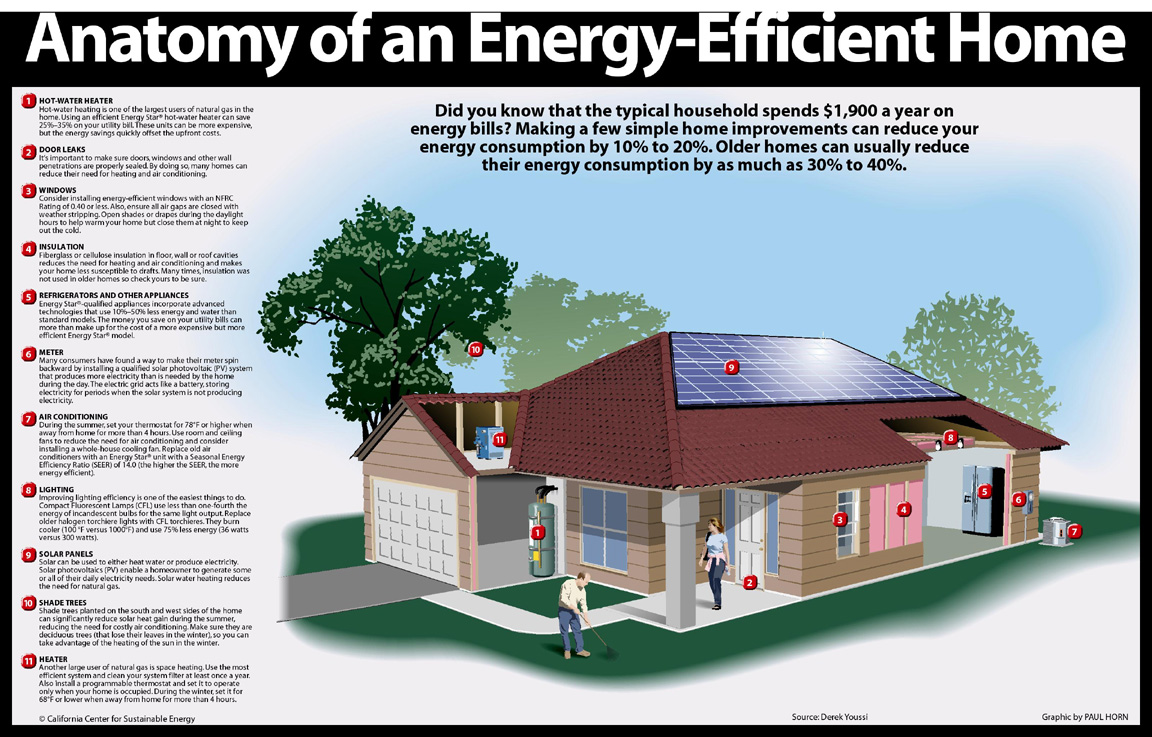Courtesy of wikiHow
Becoming more energy efficient isn’t just for those of us who want to save the environment. Being energy efficient can really help your wallet. Whether it’s something as big as installing solar panels, or something as small as turning off the lights, when you cut back on how much energy you use, you save money. There are many steps you can take to make your home more energy efficient. Some energy-efficient changes are one-time investments. Others are things you can do every day! Realize, though, that you don’t have to follow every step to be energy efficient. Even if you only implement two or three of these changes you will be saving energy, money, and the environment too.
Steps
1
Insulate your home. Adding new or additional insulation to your ceilings, attic and walls along with using caulking or weather stripping to make sure doors and windows are properly sealed will prevent cold drafts and air leaks to keep warm air inside during the freezing winter. When the weather heats up, these same improvements will help trap the cool air from air conditioning inside your home during the sweltering summer.
2
Revamp your windows. Your windows are a major source of heat loss in a home.
- Replace aluminum frames. Aluminum window frames let heat transfer very easily. Vinyl frames are much more resistant to heat transfer.
- Get multiple panes. Double- or triple-paned argon gas-filled windows are great for keeping the heat in and the cold out (the argon between the glass acts as an incredibly effective insulator).
- Tint your windows. While you may not think that tinted windows on the front of your house looks very attractive, you can always do it to the back windows. It’s surprising how much unwanted heat and cold you can keep out by having tinted windows.
- Open the blinds. Why not leave the lights off and let some sun in? Lighting your house with sunlight is 100% free!
3
Replace old appliances. Older appliances are less energy-efficient than newer models. Replace these old clunkers in your home with Energy Star certified appliances. This will go a long way towards saving energy and lowering your electric bills. When it’s time to replace your kitchen appliances, the washer, dryer, water heater, or furnace, research the various models and features so you’ll know which ones are the most energy efficient. When shopping, look for models that are labeled as “Energy Star Certified” to ensure you’re getting an energy- and money-saving appliance.
- A high efficiency on-demand water heater only fires when you call for hot water. It heats up quickly-and then quits burning fuel. (An added bonus is the fact that they are amazingly easy to maintenance.)
- Get low-flow fixtures and appliances. Low-flow toilets, shower heads, and washing machines can save a lot of water.
- Double the savings. For example, using low-flow fixtures (like shower heads) can “piggyback” on the use of a new, energy-efficient water heater and help to further decrease the energy usage in your home.
4
Use your appliances efficiently. Study the operator’s manual for each appliance so you’re familiar with the proper operating methods. Then, be mindful of how you’re using your appliances. Minimize their energy expenditure by minimizing their use. Do full loads of clothes and dishes each time. Since your refrigerator is the one appliance in your home that’s always on, maximize its efficiency by turning the temperature to the “energy-efficient” setting (if indicated on your temperature control) or to 37 degrees (3 degrees for your freezer). Also when you go on vacation don’t just turn off your appliances, unplug them. Even though they’re off, there is still energy that’s getting wasted.
5
Keep your water heater warm. The “warm” range (120 to 140 degrees) is fine. In fact, newer water heaters will turn the temperature down to 140 if you turn it up past that. It just doesn’t need to be that hot.
6
Fix the furnace. There are a bunch of things you can do to increase the efficiency of your furnace.
- Get a high-efficiency furnace. A high efficiency furnace burns less gas, burns hotter, and produces less carbon emissions.
- Change air filters. Changing out dirty furnace filters makes it easier for air to circulate and thus makes your furnace work less.
- Seal ducts. Seal your furnace/AC duct work. Keeping air in the ducts until it reaches its destination will keep your furnace from working too much.
- Add a programmable thermostat. Another furnace fix! A programmable thermostat means that while you’re out, your furnace won’t come on. However, before you come back home the furnace will turn back on and your house will be warm.
- Close the vents in rooms you use less frequently in your home, like guest bedrooms, so you’re only heating or cooling rooms that are occupied.
7
Switch from incandescent to fluorescent. Although compact fluorescent bulbs cost more initially, the end result is considerable savings. This is because fluorescent light bulbs last 8-12 times longer than incandescent bulbs. Even using a mix of fluorescent and incandescent lighting throughout your home can have an impact in overall energy usage.
8
Add solar panels. Adding solar panels to your house can help you cut down on energy costs by helping you produce a little bit of your own electricity.
9
Plant a tree. Outside your home, plant deciduous shade trees in your yard on the side of your house that gets the most intense sun during the summer months (usually the side with the western exposure). The tree and its leaves will then provide shade during the hottest time of day and naturally help to keep your home cool. In winter, when the tree will be bare, it will allow warm sunshine into your home during the most optimal time of day.
10
Finally, make sure to take advantage of the tax incentives for energy-efficient home improvements that are available through the federal government. Recent increases in incentives now allow for up to 30% of the cost of home improvements — like new windows, insulation, heating, or air conditioning — to an existing home to a maximum of $1,500. That’s money back in your pocket in addition to your power bill savings!
- 11
Buy or build a rainwater collection system. Rainwater collection systems allow you to trap rainwater that would otherwise become runoff. That trapped water can then be used as irrigation water for your lawn or plants.
Tips
- Replacing the older appliances in your home with Energy Star certified appliances can also go a long way towards saving energy and lowering your electric bills.
- Fluorescent light bulbs are great for places that have lights on for a long time. However, if the light is always going on and off, it can shorten their life-span.
- Programmable thermostats control climate and allow for customized temperature settings during the day, evening, and even when you’re away from home on vacation.
- Replacing old windows with windows that provide better insulation will keep the elements out during the extreme weather seasons of summer and winter.
- Remember that there are government grants/rebates for making your home energy efficient.
- Home improvement loans can help you cover the initial cost — and then the savings pay it all back.
- Use lighting control devices like motion detectors, dimmers and etc to provide the right amount of light where and when it is needed.
















